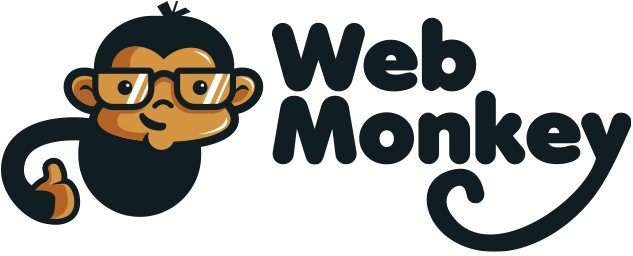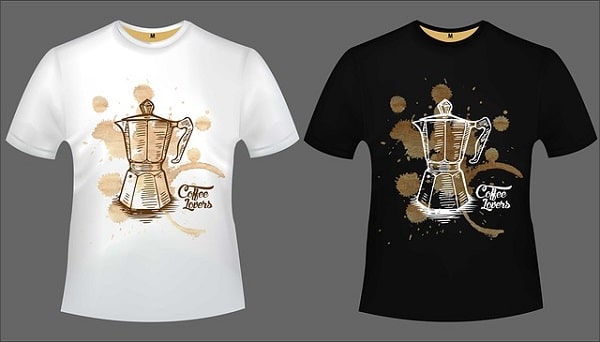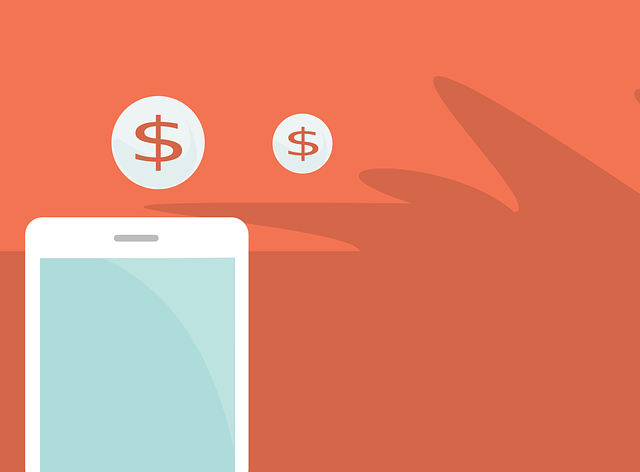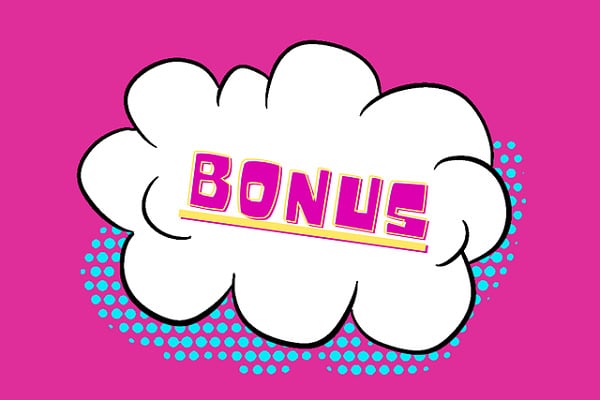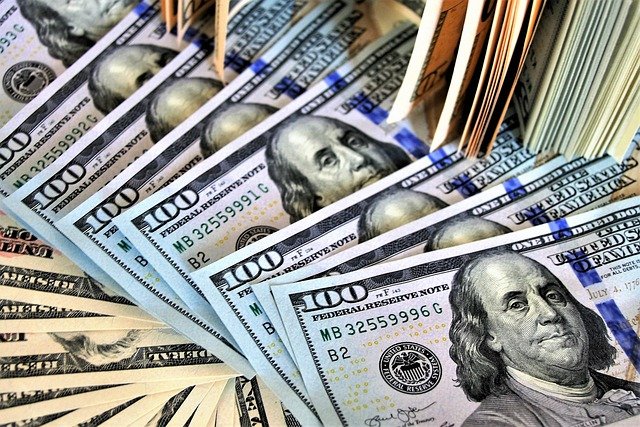Teespring vs Redbubble – The Ultimate Guide For Artists
One incredibly popular way to make money online is to sell print on demand products.
Print on demand, or POD, is really an excellent business model for artists and creatives to earn passive income with their designs.
And, there are so many marketplaces you can try, from selling POD products on Etsy to trying websites like Society6.
Two of the most popular POD marketplaces are Teespring and Redbubble.
But if you're new to this side hustle, which platform is best? And, where should you start selling first?
Well, our Teespring vs Redbubble breakdown is covering everything you need to know about these two leading marketplaces so you can make the right decision for your POD business.
About Teespring (Spring)
Teespring is an American ecommerce company that began in 2011.
The company has recently rebranded to Spring and lets creators sell their own merchandise through their own storefront or with social media.
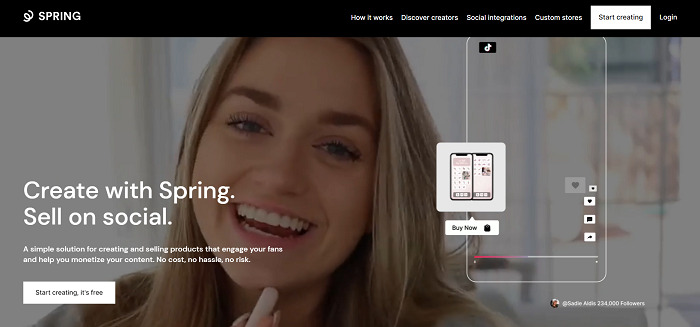
Spring and Teespring are still used somewhat interchangeably, but the fact remains, this is one of the best ways to sell print on demand products to your existing social media audience.
About Redbubble
Redbubble is an Australian ecommerce company that began in 2006, making it one of the older players in the space.
Now, there are a lot of sites like Redbubble, but Redbubble has really cemented itself as an industry leader due to its size and ease-of-use for artists.
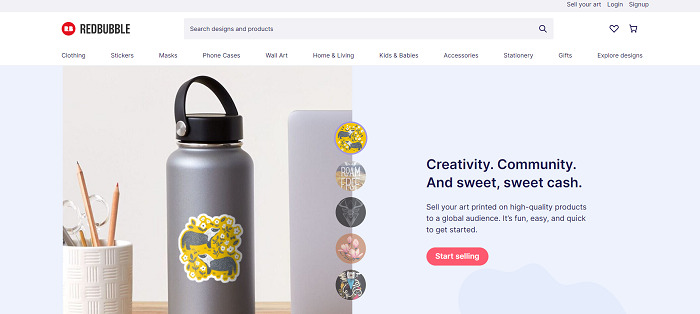
On Redbubble, you can quickly launch your own storefront, upload your designs to over a hundred products, and begin selling to customers around the world.
According to Redbubble, over 700,000 artists around the world use the platform, and if you're looking for a beginner-friendly way to try POD selling, Redbubble is definitely for you!
Teespring vs Redbubble – The Features
Choosing between Redbubble or Teespring can be difficult because both platforms have a lot in common.
However, there are some distinct differences, especially when it comes to integrations and pricing, that might make one platform superior to the other.
1. Store Setup
Part of choosing the right POD platform to sell online is how easy it is to set up your store.
No one wants to jump through hoops to launch their storefront, so let's look at how Teespring and Redbubble compare on this front.
Teespring Setup
Signing up for Teespring and creating a store with Spring is free and just requires your email address.
Once you sign in, there are four steps to launching your Teespring store:
- Choose a product to create
- Start designing
- Add your product to your store
- Keep designing
Spring recommends starting with at least 10 products in your storefront, so it's a good idea to have a few designs ready to go.
In terms of actually designing your store, the Spring store editor is rather beginner-friendly and lets you edit your storefront's color, layout, and text.
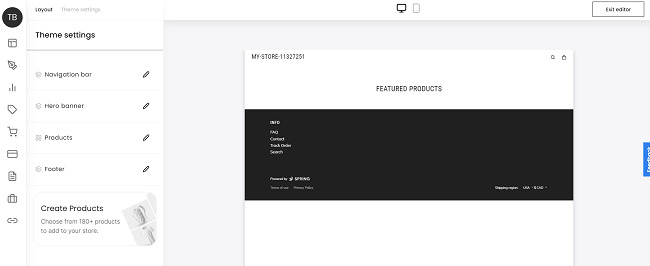
You don't have as much control as launching your store with something like Sellfy or Shopify, but it's very easy to start selling POD products with Teespring.
If you have your own domain name, you can also connect it to your Teespring store, which is nice since it makes your store look more professional.
Redbubble Setup
Making money with Redbubble and launching your own store is also pretty straightforward.
Additionally, you can create your Redbubble store for free, just like Teespring.
To setup your Redbubble store, you upload designs and choose the products you want to add your designs to.
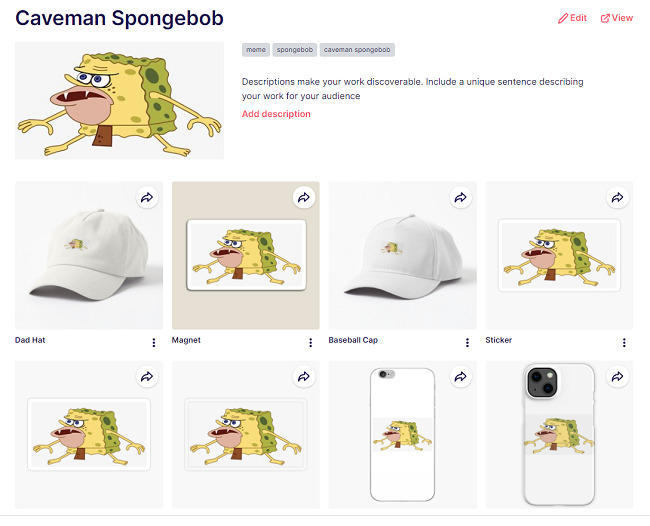
From there, you connect a payment method to your account to finish opening your Redbubble shop.
You have to verify your email address as well, and overall, it takes a bit longer to open your Redbubble store than it does with Teespring.
Additionally, I find Redbubble's backend to be a little clunkier than Teespring, but it's still easy to manage your shop settings and to begin tweaking your storefront's design.
Winner: Spring is slightly faster to set up and makes designing your store easier.
2. Product Catalogue
Having a robust catalogue is another important factor to consider when picking between Redbubble vs Teespring because generally, the more variety, the better.
POD selling is all about coming up with new designs and testing new products. Therefore, having more products you can upload your designs to is a good thing.
You also want your POD platform to have popular products; think apparel, mugs, and stickers.
Teespring Products
You can upload your designs to over 180 products in your Spring store, including products like:
- Apparel
- Accessories
- Canvas prints
- Digital downloads
- Leggings
- Mugs
- Pint glasses
- Pillows
- Seasonal collections
- Socks
- Tote bags
- Yoga mats
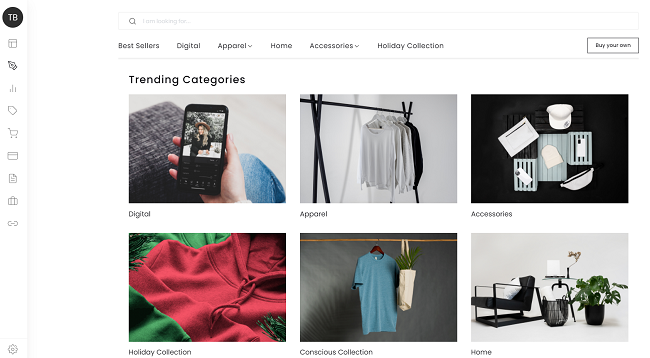
The bottom line is you won't have trouble finding products to add your designs to for your Teespring store.
Redbubble Products
Redbubble lets you add your designs to over 80 products, so there's slightly less selection than with Teespring.
But Redbubble still has plenty of product variety, including popular sellers like:
- Apparel
- Artwork
- Coasters
- Home goods
- Mugs
- Phone cases
- Pillows
- Socks
- Stickers
- Tote bags
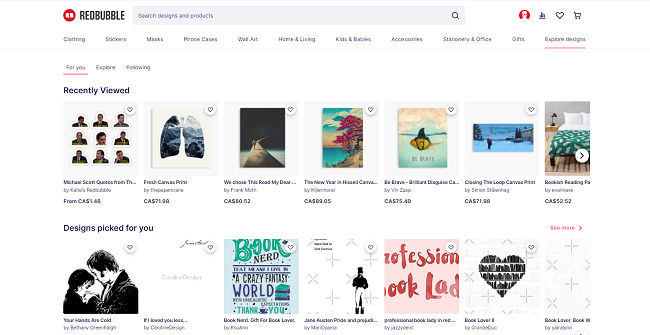
However, Teespring lets you sell digital downloads through your store, which is a significant difference between Teespring and Redbubble.
Winner: Both platforms are similar. Redbubble has more products under home goods and kids whereas Teespring lets you sell digital products as well.
3. Artist Margins
POD platforms all charge a certain amount to cover the cost of manufacturing and shipping.
But, it's nice to have control over your own margins. And, you want to avoid print on demand marketplaces that have absurdly high fees, leaving little room for profit.
Teespring Pricing
It's free to sell through your Spring store, and you get to set your own sale price so you have control over your margins.
This is good news for any POD platform since the more control you have over your profit margin, the better.
However, Teespring gives you a discount on merchandise the more you sell, so high-volume stores have higher profit margins than small stores.
Here's Teespring's current merchandise pricing table:
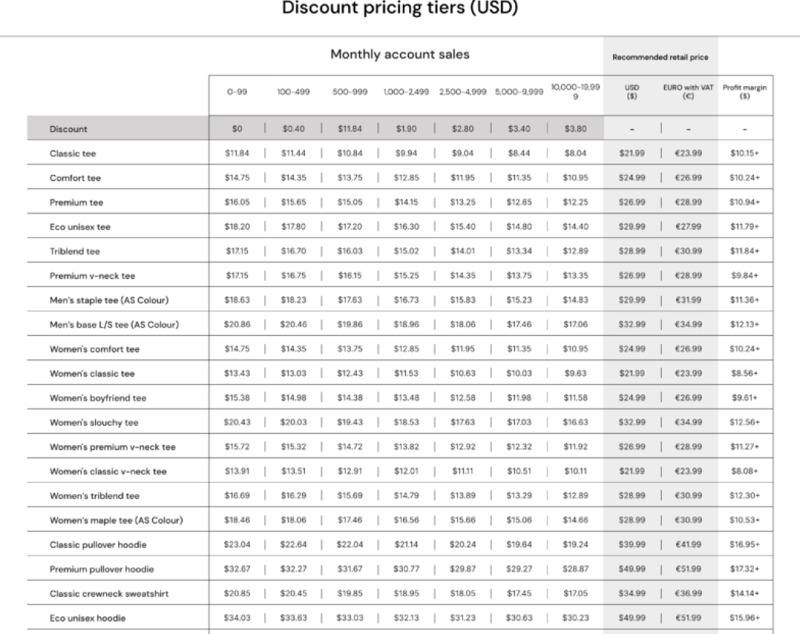
As you can see, a classic t-shirt costs $11.84 to manufacture if your store gets under 100 monthly sales. But you can get up to a $3.80 discount if you sell an insane number of t-shirts.
Realistically, most POD stores won't get more than a $0.40 discount on merchandise since this requires having over 100 monthly sales, but that still adds up!
Teespring also has recommended retail prices for its merchandise, which is around $21.99 for t-shirts and $39.99 for basic hoodies; pretty standard in the world of print on demand.
Redbubble Pricing
Like Teespring, selling on Redbubble is also completely free. You also have complete control over your magin and set your final sales price.
I like Redbubble's pricing table more than Teespring since you can adjust your artist margin and automatically see how much you make in profit per sale.
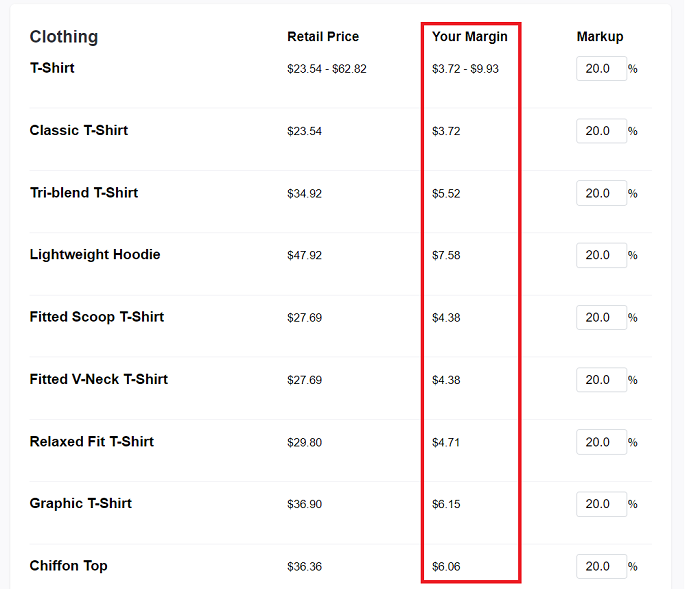
At a 20% margin, Redbubble products are slightly more expensive than Teespring products in most categories, and if you compare the two tables above, it seems like you can make slightly more profit per sale with Spring.
However, this all depends on your niche, the products you sell, and how you price your merchandise, so it's tough to pick a winner between Redbubble and Teespring when it comes to pricing.
Winner: Both platforms let you set your own margins, although I like that Teespring gives high-volume stores discounts on merchandise.
4. Fulfillment & Shipping
Another factor to think about when choosing between Teespring or Redbubble is how order fulfillment and shipping works.
Ideally, you want shipping to be fast and affordable. This leads to a higher margin and also leads to happier customers.
Teespring Fulfillment
Teespring ships to most countries in the world, and customers pay for shipping, so shipping costs don't hurt your bottom line.
How much customers pay in shipping costs depends on where they live, the number and weight of the items they buy, and the courier they end up working with.
Honestly, as a print on demand seller with Teespring, you don't have to worry about shipping or order fulfillment since this work is handled for you.
Redbubble Fulfillment
Redbubble and Teespring are basically the same when it comes to order fulfillment and shipping.
Like Teespring, Redbubble customers pay for shipping, so you don't have to worry about this cost impacting profits.
Redbubble also ships to most countries in the world, and shipping costs depend on the same factors as with Teespring.
Winner: Redbubble and Teespring don't have any notable differences when it comes to order fulfillment.
5. Market Size
The main reason people sell on sites like Zazzle, Redbubble, and Teespring is to leverage an existing marketplace and get sales more quickly.
However, this is one area where Teespring and Redbubble differ substantially, so this might be where you pick a winner!
Teespring Market Size
One of the main differences between Teespring and Redbubble is that Teespring is more of a standalone ecommerce platform whereas Redbubble is a marketplace.
When you launch your Spring store, you're basically creating an online portal where you can drive your fans to in order to sell your merchandise.
However, the odds of someone finding you organically on the internet or on Spring's website is very low.
Spring does have a “Discover Creators” section of its website where it highlights popular creators, but there isn't a central marketplace with millions of active buyers.

Redbubble Marketplace
Unlike Teespring, Redbubble has a large, active marketplace of buyers.
In fact, according to SEMRush data, Redbubble gets over 29 million monthly organic visitors alone!
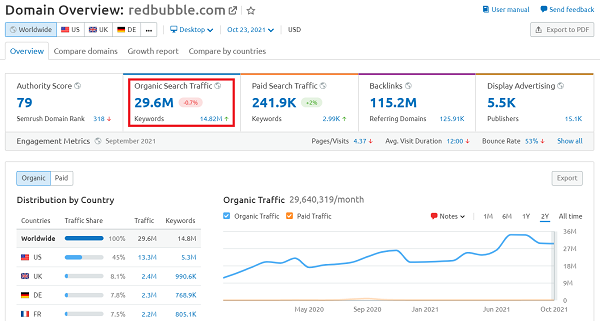
Redbubble also lets you add tags to your products to help describe what they are and what niche your merchandise is in. This helps shoppers find your products organically as they search on Redbubble.
This is the main difference between selling on Redbubble vs Spring, and the fact people can find your listings organically on Redbubble is a massive perk.
Winner: Redbubble has an active marketplace and way more monthly visitors than Teespring, making it the better choice if you don't already have a following.
6. Customer Support
Customer complaints, returns, and questions are an inevitable part of selling stuff online.
But, this means you want your POD platform to have reliable customer service so you can keep your customers happy and don't have to worry about handling support questions yourself.
Teespring Customer Support
For sellers, Teespring has decent customer support and offers support through live chat and email.
According to its contact page, Teespring also answers questions within 24 business hours.
For buyers, Teespring offers live chat support seven days a week.
Redbubble Customer Support
Redbubble funnels sellers and buyers through its help center if they have questions.
The help center is basically a library of answers to common questions people have. If you can't find your answer, you can submit a support ticket online.
There isn't any live chat option or phone number I can find, which is a downside.
Winner: Teespring has better customer support than Redbubble.
7. Integrations
Some print on demand marketplaces integrate with third-party software, but many don't. This can be a massive limitation and also influence your decision on which platform to sell with.
Teespring Integrations
Since Teespring has rebranded to Spring, it's made massive strides in the number of integrations it offers.
In fact, integrations are probably one of the main factors you should look at when deciding between selling on Teespring or Redbubble.
Currently, you can integrate your Spring store with:
- Discord
- Linktree
- Twitch.tv
- YouTube
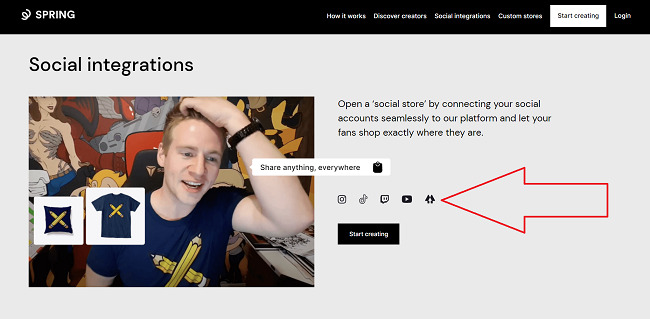
In other words, you can launch your Spring store and then sell your products directly on platforms like YouTube or your Twitch stream.
For content creators who have a following, this makes Teespring one of the best ways to sell merchandise online.
Redbubble Integrations
Unlike Teespring, Redbubble doesn't let you integrate your designs with other platforms or sell across social media.
You can add your social media handles to your Redbubble store, but this isn't nearly as useful as Spring's integrations.
Redbubble lets you copy HTML to display your products on your own website, but this is as a far as integrations with Redbubble go.
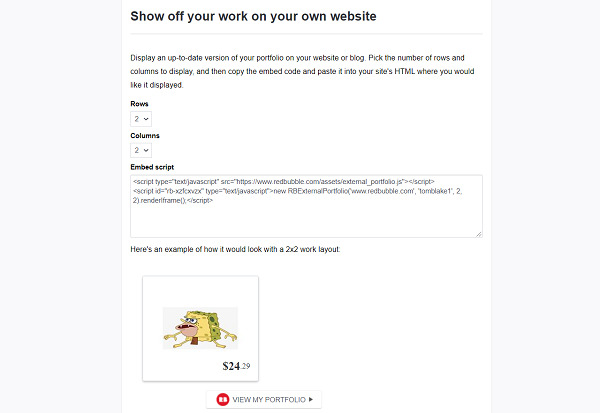
Winner: Teespring has more integrations than Redbubble.
8. Product Quality
A final factor to consider in the Teespring vs Redbubble debate is product quality.
To keep customers happy and limit returns, you want your POD provider to manufacture high-quality products that also look the same in-person as they do online.
Let's take a look at what users say about Teespring and Redbubble product quality.
Teespring Product Quality
The best way to test product quality for a POD platform is to order merchandise yourself so you can inspect it.
I've done this before for companies like Printify, which is my POD platform of choice.
Anyway, for Teespring product quality, here's a great review I found on YouTube.
In this review, Zain, the Youtuber, states he ordered a t-shirt from Teespring and some of the printed white text was a bit patchy.
However, he is happy with the coloring and that the quality gets the job done overall.
Redbubble Product Quality
Like Teespring or any POD provider, I recommend ordering your own products from Redbubble to test the quality if you're serious about selling on this platform.
However, I found a very insightful Reddit thread where different Redbubble buyers share their experience with ordering from the site.
Here's what the buyers say about Redbubble print quality:
- onewaytriggr says: “Shirt I have is really good quality!”
- mrsirdeesir says: “The thing with Redbubble is that they let the merchant choose their textile. Some are bad, some are great. Hopefully the material is listed under product descriptions.”
- mocranks says: “Everything I've gotten is great. Shirts and phone cases have lasted for years, through many drops/washes.”
- prowl16 says: “I got a really cool Comedown Machine T Shirt from Redbubble a few months ago and it's great quality, hasn't shrunk or anything and still looks great.”
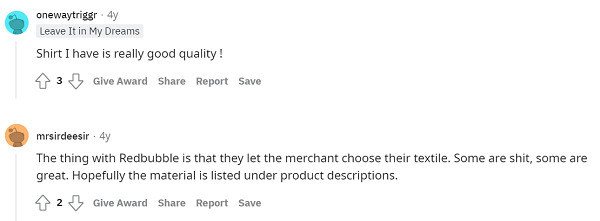
The thing with POD is that product quality is always going to be a bit worse than selling premium merchandise that's not made at scale and with the goal of cutting costs.
But, both Teespring and Redbubble get the job done, so you shouldn't be swamped with customer returns and complaints.
Winner: Teespring and Redbubble have decent print quality, but you should always test products yourself before ramping up your store.
Pros & Cons
If you're still wondering about if Redbubble is better than Teespring or not, here are some of the pros and cons of each platform to consider.
Teespring Pros
- Easy-to-use store design tool
- Over 150 products you can sell
- You can sell digital products
- Integrates with social media platforms to let you sell directly to your audience
- Strong buyer and artist customer support
Teespring Cons
- Not organic marketplace where buyers can discover your merchandise
- Mostly for content creators who want to sell to an existing audience
Redbubble Pros
- Massive marketplace with millions of visitors so people can find your listings organically
- Sell over 80 products
- Easy-to-use pricing tool
Redbubble Cons
- Slightly worse customer service than Teespring
- Lack of integrations with social media or other applications
- You can't sell digital products like you can with Teespring
The Verdict: Is Teespring Better Than Redbubble?
If you're still wondering if you should sell on Redbubble or Teespring, here is how you can make the decision that's right for your POD business.
Sell On Teespring If…
Selling on Teespring is better than Redbubble if you already have an existing audience on social media, YouTube, or Twitch.
The fact that you can integrate your products directly into social media is one massive advantage Teespring has over Redbubble.
If you want to run a standalone shop and don't want to sell on a marketplace, opening a Spring store is also for you.
Finally, the fact that you can sell digital products with your Spring store is another selling point.
Sell On Redbubble If…
Redbubble is more beginner-friendly than Teespring because you can sell to a marketplace of millions of buyers and people can find you organically.
So, if you don't have an existing following on social media and want an easier time getting discovered by customers, choose Redbubble over Teespring.
Sell On Both Platforms If…
Many POD sellers list their designs on multiple platforms to increase exposure, and this is honestly a great idea.
Redbubble and Teespring are free to sell on, so nothing stops you from trying both platforms to find the right fit.
I'd start with Redbubble if you're new and then expand to a Spring store if you want to build a standalone ecommerce storefront.
In contrast, if you already have a decent following, start with Teespring and then relist your designs on Redbubble.
Extra Reading – How To Make $1,000 In 24 Hours.
Final Thoughts
I hope our Teespring vs Redbubble breakdown helps you pick the right platform to sell on.
As mentioned, there are so many POD platforms out there, and this is really just scratching the surface.
Personally, I use Printify and connect it to Etsy or Shopify whenever I experiment with POD selling, so this is another option I recommend exploring if you want more artist control.
Whatever you choose, I hope your venture into print on demand is a success and helps you boost your monthly income!
Looking for more ways to make money online? Checkout:
- How To Start An Etsy Sticker Business.
- Big Cartel vs Etsy – What's Best For Sellers.
- How To Make Money Selling Memes.
